The Lima Metro has just one line with 26 stations in 35 kms.
The time to travel the whole line is approximately an hour.
From Monday to Sunday trains run from 6:00 a.m. to 11:00 p.m.. Frequency varies according to the day and time.
The price of a single trip is 1.5 soles (0.45 USD)
Metros in Peru: The Lima Metro
Lima, the capital of Peru, is one of the most populated Latin American cities of the region, thanks to its population of 8.5 million inhabitants. In fact, it is the third biggest metropolitan area in regards of number of inhabitants, just under Buenos Aires and Mexico City.
A long time ago, this city became a cultural, political, economic and financial center in the country. This is largely due to the fact that there is a big centralist movement that persists on the South American nation.
Also, the economic growth that Peru has experimented on the last few years has put Lima on a position of great importance. This growth has occurred since the city has an important number of qualified workers.
Precisely, for this last reason, the local authorities from the region began to consider the possibility of beginning projects involving the construction of infrastructures that would offer an answer to the increasing transportation demand of the people of Lima.
The project´s beginnings date back from the 80s, but it would be paralyzed when the 90s began due to issues regarding corruption, which resulted in an incomplete construction. It remained like that for almost 20 years, until, in 2009, the government decided to resume the construction works.
After two years of hard work, line 1 for the Lima Metro was practically finished by January 2011, and the only work left was to electrify the railroads and restore the vehicles, which came from Italy.
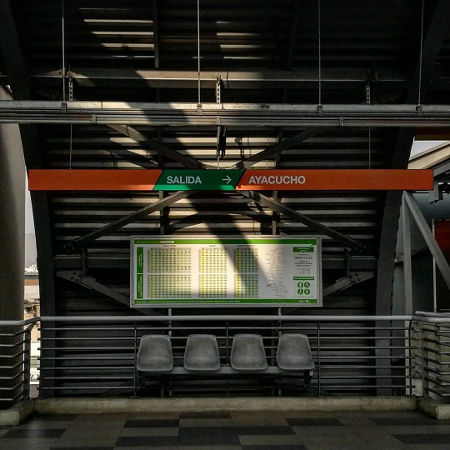 Metro de Lima
Metro de Lima
Finally, on July 11th of that same year, the first line of the system was officially inaugurated, with a 35 kilometer-long railroad and 26 operational stations. However, this is just the first phase of a more ambitious project that has the goal of connecting the entire capital with many lines.
Line and stations
The Lima Metro only has one commercial line, which is comprised of 35 kilometers of road and 26 stations. This line’s journey goes from the northeast of Lima to the south, crossing through 11 districts during the ride. Its trains transit at ground-level in the south, but they start to transit at elevated roads after reaching downtown and while heading to the north. On average, the vehicles manage to go through 35 kilometers in around an hour.
The system´s stations are the following:
- Villa El Salvador Station: Located at the south of Lima, this is the southern terminal station of this line. It lies between Juan Velasco Alvarado Avenue and Separadora Industrial Avenue, on the vicinity of Villa El Salvador.
- Parque Industrial Station: It was one of the few finished stations during the 90s, and it is located on the Villa El Salvador District. Specifically, it is located between Separadora Industrial Avenue and El Sol Avenue.
- Pumacahua Station: Just like the previous station, it was also inaugurated during the 90s, on the Villa El Salvador district. It is located at La Unión Avenue, just at the intersection between Pedro Ruiz Gallo and E. Aguirre.
- Villa María Station: This station was built to give service to a residential zone at the Villa María del Triunfo district. It is located at Pachacútec Avenue, just at the intersection with Santa Rosa Avenue, and quite close to Villa María Avenue.
- María Auxiliadora Station: This stop is also found at a residential area from the Villa María del Triunfo district. It was built at Pachacútec Avenue, on the intersection with Manco Cápac Avenue.
- San Juan Station: This station serves the people in the vicinities of the San Juan de Miraflores district, and was built at Los Heroes Avenue, on the intersection with Canevaro Avenue.
- Atocongo Station: Just like the previous station, this one lies on the San Juan de Miraflores district. To be more specific, it was built on Los Heroes Avenue, close to the road that connects with the Panamericana Sur Highway.
- Jorge Chávez Station: The current stop was built on the Surco district, on the vicinity of the avenues Tomás Marsano and Jorge Chávez. This is a heavily populated residential area.
- Ayacucho Station: It is also located on the Surco district, but, this time, it is located on an area with more businesses. It is located on the Tomas Marsano Avenue, at the intersection with Ayacucho Avenue.
- Los Cabitos: This stop is found on the vicinity of the Santiago de Surco district, specifically, at Aviación Avenue, which is quite close to the Ovalo Los Cabitos sector.
- Angamos Station: This station was inaugurated on the year 2011, and was built at Aviación Avenue, just at the intersection with Angamos Avenue of the San Borja district.
- San Borja Sur Station: Just like the previous station, it was inaugurated on the year 2011 on the San Borja district. It lies between Aviación Avenue and San Borja Sur Avenue.
- La Cultura Station: It is located in a commercial area of the San Borja district, just at the intersection between the avenues Javier Prado and Aviación. This place is also known for having many cultural places.
- Nicolás Arriola Station: This stop is located on the La Victoria district, in an area with a mix of residences and businesses. It is located on the Aviacion Avenue, near Óvalo Nicolás Arriola.
- Gamarra Station: It lies on the La Victoria district, in an area with a lot of commerce. It is located in the intersection between Aviación Avenue and Hipólito Unanue Street.
- 28 de Julio Station: Just like the previous station, it was built on the La Victoria district, but, this time, it´s on Aviación Avenue, just at the intersection with 28 de Julio Avenue. This is why it is called 28 de Julio.
- Miguel Grau Station: This station is located on the Cercado de Lima district, just at the intersection among the avenues Nicolás de Ayllón, Aviación, and Miguel Grau.
- El Ángel Station: This stop lies on the El Agustino district, specifically, at Locumca Avenue, next to El Ángel Cemetery. The name of the cemetery is the reason why this station is called El Ángel.
- Presbítero Maestro Station: Just like the previous station, this stop is located at the Cercado de Lina district, at Locumba Avenue, quite close to the Presbítero Maestro Cemetery.
- Caja de Agua Station: It is an elevated station, located on the San Juan de Lurigancho station, at the Próceres de la Independencia Avenue, right on the vicinity of Óvalo Zárate.
- Pirámide Del Sol Station: This station is located on the San Juan de Lurigancho district, on the Próceres de la Independencia Avenue, on the intersection with Pirámide del Sol Avenue.
- Los Jardines Station: Just like the two previous stations, this station is located on the San Juan de Lurigancho district, on the intersection with Próceres de la Independencia Avenue and Los Jardines Avenue.
- Los Postes Station: This station was built on the Próceres de la Independencia Avenue, on the intersection with Los Postes Avenue. It offers service to the inhabitants of the San Juan de Lurigancho district.
- San Carlos Station: This is an elevated kind of station, and it is built on the San Juan de Lurigancho district, or to be more precise, on the Próceres de la Independencia Avenue, on the intersection with El Sol Avenue.
- San Martín Station: This station is an elevated type of station, and it is located on the San Juan de Lurigancho district, on the Fernando Wiesse Avenue, right on the intersection with the Canto Rey Avenue.
- Santa Rosa Station: Just like the previous stations, it was also built on the San Juan de Lurigancho district, and it is also elevated. It is located on the Fernando Wiesse Avenue, on the intersection with Santa Rosa Avenue.
- Bayóvar Station: It is the terminal station of the northeastern end of the line, and it lies on the San Juan de Lurigancho district. It is located on the Fernando Wiesse Avenue, on the intersection with Héroes del Cenepa Avenue.
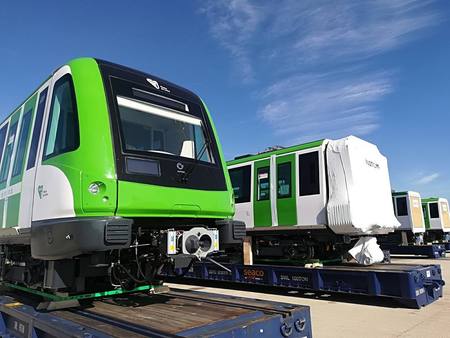
Schedule
The Lima Metro´s business hours are quite convenient for its users, even though it is not open for 24 hours straight. From Monday to Friday, the trains start offering service from 6:00 am, and they keep operating non-stop until 11:00 pm. During these days, the train frequency is around 7 minutes per train. However, during peak hours, the train frequency is considerably reduced to just three minutes.
In the case of Saturdays, the opening and closing times remain the same, but the waiting time between trains changes. During the regular course of the day, the vehicles reach the platforms every 7 minutes, with the exception of peak hours, in which the waiting time between trains is of only five minutes.
On Sundays and holidays, just like on Saturdays, the business hours once again remain the same. However, the train frequency is around 10 minutes per train all day long.
Fares and tickets
The Lima Metro offers you two ways to pay for your trip on the system. In both cases, the passengers should buy a reloadable card, since the metro´s authorities chose to not to sell the standard tickets any longer.
The cards are the following:
- Half Fare Card: as its name indicates, this card offers a 50% discount off the journeys for the user of this option. However, this card is not available for everyone. Only students from elementary school, middle school, high school, college or any other students enrolled in educational institutes recognized by the education ministry can choose to buy this card.
- Adult Pass Card: This card lets any passenger travel on the Lima Metro, as long as they have enough money loaded into it. There is no age limit for you to buy the Adult Card. However, if eligible, it is recommended that you apply to get the Half Fare Card as quickly as you can.
Prices
The cost of the Adult Card is of five Peruvian Soles (1.50 USD), while the Half Fare Card is completely free. With the Adult card, the price for each journey is of 1.5 Soles (0.45 USD.) Meanwhile, students only pay 0.75 Soles (0.22 USD.)
Note: Children under six years of age can travel for free if they travel with their legal guardian. Likewise, members of the national police and fire fighters do not have to pay any fee to travel on the system.
The reduced fare for students is not available during holidays nor during vacation periods.
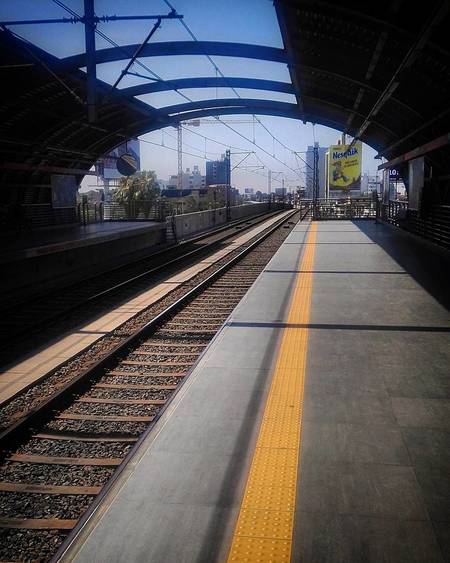 lima Metro
lima Metro
Rules
The Lima Metro´s rules are divided in different sections, with the goal of making them as clear as possible to the passengers.
Rules during the journey
- You cannot carry with you any luggage that may represent an obstacle for the rest of the passengers. If you disobey this rule, you may get a fine.
- The Lima Metro´s authorities ban the act of transporting pets or any other kinds of animals within the system´s facilities. The only possible exception to this rule are properly identified guide dogs.
- With the purpose of make the trip safer and more comfortable, both for you and for the rest of the passengers, put your backpack in front of your chest.
- You cannot smoke on the metro´s facilities.
- While moving around the platforms, try to walk on the right side. This way, everyone will be able to commute faster on the stations.
- Try to be aware of the seats that are identified to be exclusively used by people with disabilities, senior citizens, and pregnant women.
Safety rules
- It is mandatory that all passengers keep a proper distance from the yellow line. If you cross it while waiting for the next train, you may be fined.
- You should refrain from carrying elements that are flammable or potentially dangerous for other passengers. This includes poisonous substances, dangerous chemicals, and fireworks.
- Avoid running on the metro´s platforms. Said action could lead to regrettable consequences.
- If you bring a stroller with you, you have the option of either folding it so that it doesn´t disturb other passengers, or you may go to one of the ends of the first or the last wagon.
- For your safety and that of the other passengers, you may not enter the Lima Metro´s facilities under the influence of drugs or alcohol.
Rules of conduct
- It is quite important that you follow the instructions of the metro´s personnel, especially during emergency situations.
- It is not recommended the use of multimedia devices without headphones within the metro´s wagons, since you could disturb other passengers and make them feel uncomfortable.
- Avoid trying to obstruct the doors while they are closing. If any member of the metro´s personnel sees you, you may get fined.
- You cannot lie down on the platforms nor on the stairs of the stations.
- You cannot beg on the Lima Metro´s facilities.
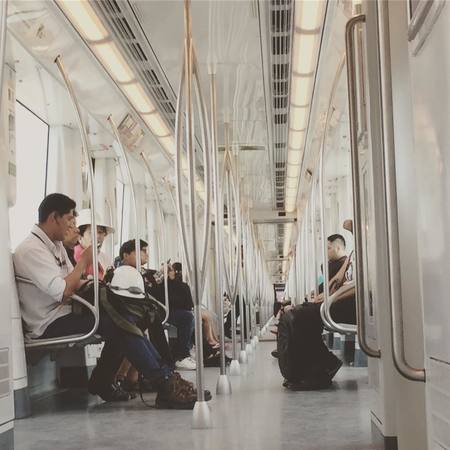 lima Metro
lima Metro
Fun facts
- The Lima Metro transports 380 thousand passengers daily. The metro´s authorities expected to have this number of daily passengers by the year 2035, which is why they are currently in a rush to expand the system´s capacity.
- The system´s line 1 has some Italian trains that date back from the 80s, which were reconditioned and renovated so that they could offer service. However, the newest trains on the system are from French origin.
- On its beginnings, the Lima Metro was planned as a fast tram. However, after relaunching the project, the authorities decided to transform it so that the metro used heavy trains, like regular metro services do.
- The Lima Metro has an arts and culture program, which promotes events, works, expositions, and some other artistic exhibitions on the stations with the highest influx of people.
- Even though it is called the Lima Metro, the truth is that this system also serves other districts that do not belong to the Lima metropolitan region, such as the adjacent municipality of El Callao.
Connection to the airport
Sadly, the Lima Metro is not linked with the Jorge Chavez International Airport, but there are some available alternatives. The alternatives are the following:
The first option is the Airport Express Lima, a bus line equipped with air conditioning, Wi-Fi, and USB chargers on the seats. This bus line started offering service a few years ago. It was proposed to compensate for the city’s deficiencies in regard of public transportation, such as being unable to reach to the country’s most important airport. However, this bus line does not have any stop in any of the metro stations of the railway system, so you will need to use another transportation service to use said bus line.
The Airport Express Lima lies on the Miraflores district, right at downtown Lima, which is one of the points of reference of the city due to its commerce and culture. To reach it by using the metro, you should get off at the closest stop, which is the Angamos stop. Even though it is relatively close, it is not within walking distance.
Therefore, it is recommended that you use a taxi to move around. Other means of transportation, such as the ones known as the Combis, are not recommended at all due to the high likelihood that you’ll get mugged in them.
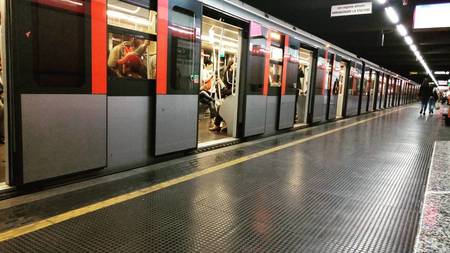 Corso Buenos Aires Milano
Corso Buenos Aires Milano
Once you have reached the district, and after you have ridden on one of the express bus lines, the journey will only last between 25 and 30 minutes. The single ticket price is of 8 USD, while the round trip ticket costs 16 USD. You can pay for your trip in either Peruvian Soles or American Dollars.
The journey is the same if you want to do it the other way, from the airport to downtown Lima. However, you can also find just outside the airport taxi lines and rent-a-car services, which serve as your second and third transportation options if you don’t want to use the bus. Also, these services are way better options than moving around via Combis or other transportation options. The airport lies in one of the most dangerous areas of the Peruvian capital, so you will need to be cautious.
Future expansions
The Lima Metro has had expansion plans since its beginnings. The final project states that six metro lines in total will be built. As a consequence, the authorities have been constantly been spending funds for this work.
In fact, line 2 has been under construction since the year 2012, when the president Hollanta Humala approved the needed funding. A state agency called Proinversión was in charge of the research, as well as everything else related with the planning and structure of the work. The objective was to obtain all the needed data so that private firms could help with the project. Thanks to the analysis done to all of the compiled data, the construction of line 4 was also approved.
After approving the project, the firm in charge decided to build line 2 completely underground. It is expected that this line connects the city from east to west, and that it joins with line 1 at 28 de Julio station. Also, this line will have access with the metropolitan bus station, which is located at Plaza Grau. The same firm will have to be in charge of the construction of the first 8 kilometers of line 4. Line 4 will go from the north of the city towards the south, and it will have a stop at the Jorge Chavez International Airport.
Meanwhile, the national government is also currently doing research in order to build line 3, which, in a similar fashion than lines 1 and 4, will allow trains to travel through the north of the city towards the south. The current blueprint states that six commercial lines will be built, which are planned to be inaugurated on the year 2035.
Touristic attractions:
On the last few years, Lima has become one of the most visited touristic destinations in South America. For instance, near the Canada station you can find the popular Reserve Park, which is also popularly known as the Magic Water Circuit. In it, you can enjoy the sight of beautiful fountains that are available in its surroundings. They are especially charming during the night, when a lights display accompanies the water coming from the fountains.
Its diversity makes it a place for the whole family, and an excellent place for romantic encounters among couples. However, you will need time if you really wish to explore it thoroughly, since its surface area is of 8 hectares. Also, the number of visitors is quite large.
Another destination that you cannot miss while visiting the city of Lime is the San Juan de Miraflores district, which you can reach by disembarking at Maria Auxiliadora station. This place’s main highlight is its variety of bars, restaurants, and stores that are available for the local and international visitors. Additionally, safety is one of this place’s strong points, since it is one of the safest and cleanest areas on the Peruvian capital. In fact, in most touristic guidebooks you will discover that visiting San Juan de Miraflores is quite recommended.
Lima Tren Urbano map
- Also Known As: Tren Urbano
- Passengers/Day
- Fares: 0.29
- 24h operation: No
- Air Conditioning: No
- Walk between platforms: No
- Driverless trains: No
- Screen Doors Platforms: No
- 1.5 soles
- Lima Metro Official Website
Help us
If you consider that the information we provide is wrong, not accurated, outdated, translation contains errors, and you would like to help us to improve the file...you can contact us here.
Feel free to contact us if you dont find the system you're looking for and we'll add it as soon as we can!
Thank you very much!







